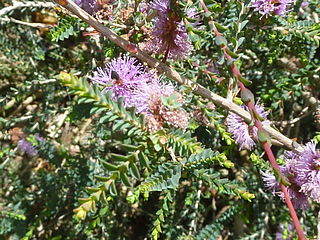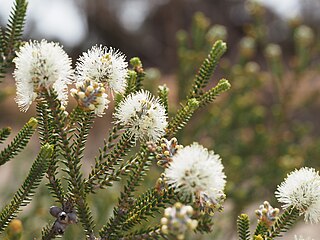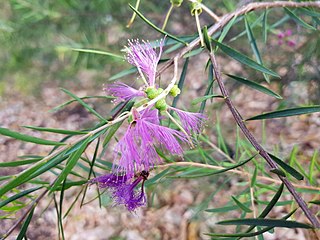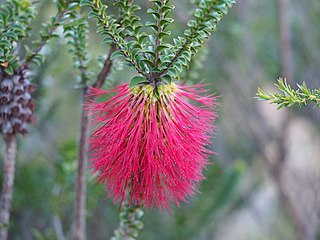
Melaleuca armillaris, commonly known as bracelet honey myrtle, is a plant in the myrtle family, Myrtaceae, and is native to South Australia, Victoria and Tasmania in south-eastern Australia. It is a hardy, commonly grown species, often used as a fast-growing screen plant, but it also has the potential to become a weed. It has become naturalised in Western Australia and parts of Victoria. In its natural state, it grows on coastal cliffs and along estuaries.

Melaleuca fulgens, commonly known as the scarlet honey myrtle, is a plant in the myrtle family Myrtaceae, and is endemic to Western Australia, South Australia and the Northern Territory. It is notable for its showy orange, red or purple flowers, unusual foliage and fruit, and is a popular garden plant. It is a member of Melaleuca, a large and diverse genus whose members range from large trees such as M. quinquenervia, to small shrubs.

Melaleuca squarrosa, commonly known as scented paperbark, is a plant in the myrtle family, Myrtaceae and is endemic to south eastern parts of Australia, especially Tasmania. It is an attractive shrub with dense foliage and arching branches and it flowers profusely in spring or early summer, bearing spikes of perfumed yellow to white flowers.

Melaleuca thymifolia, commonly known as thyme honey-myrtle, is a plant in the myrtle family Myrtaceae and is native to eastern Australia. It is often noticed in spring, with its attractive, purple flowers and is one of the most commonly cultivated melaleucas. A fragrant shrub, it usually grows to about 1.0 m (3 ft) tall, has corky bark and slender, wiry stems.

Melaleuca wilsonii, commonly known as Wilson's honey-myrtle or violet honey-myrtle, is a plant in the myrtle family, Myrtaceae, native to parts of South Australia and Victoria. It is a shrub with narrow, pointed leaves and heads of purplish-pink flowers on the sides of the branches. It is adaptable to a wide range of soils, frost hardy and often cultivated.

Melaleuca pulchella, commonly known as claw flower and claw honey-myrtle, is a plant in the myrtle family Myrtaceae, and is endemic to the south of Western Australia. It is one of only two species of Melaleuca to have two kinds of stamens. The outer stamens are longer and curved, giving the appearance of a claw to the flower. It is a hardy shrub flowering over a long period, and has been a popular garden plant for many years.

Melaleuca hypericifolia, commonly known as hillock bush, is a plant in the myrtle family, Myrtaceae, genus Melaleuca and is endemic to New South Wales in Australia. It has large, orange to red flower spikes and consequently is a commonly cultivated species. In 1797, James Edward Smith described the plant as:

Melaleuca uncinata, commonly known as broombush, broom honeymyrtle or brushwood, is a plant in the paperbark family native to southern Australia. It is harvested from the wild, and grown in plantations, for broombush fencing. The Noongar names for the plant are kwytyat and yilbarra.

Melaleuca gibbosa, commonly known as the slender honey-myrtle or small-leaved honey-myrtle is a plant in the myrtle family, Myrtaceae and is endemic to southern Australia. It is a dense, bushy shrub to about 2 metres (6.6 ft) with numerous slender, arching branches and oblong heads of mauve flower spikes in spring and sparsely throughout the year.

Melaleuca calycina is a shrub in the myrtle family, Myrtaceae, and is endemic to the south-west of Western Australia. It is a stiff, erect shrub with oval to heart-shaped leaves, white flowers and star-shaped fruit.

Melaleuca densa is a shrub in the myrtle family, Myrtaceae and is endemic to the south-west of Western Australia. It is a bushy shrub with profuse cream, yellow or greenish flowers and overlapping leaves on the youngest shoots.

Melaleuca diosmatifolia, commonly known as rosy paperbark and pink honey-myrtle is a plant in the myrtle family, Myrtaceae and is native to Queensland and New South Wales in Australia. It was formerly known as Melaleuca erubescens but is not closely related to Melaleuca diosmifolia although the species name has the same meaning. It has pointed, non-prickly leaves and cylindrical spikes of pink or purple flowers.

Melaleuca diosmifolia is a plant in the myrtle family, Myrtaceae and is endemic to the south-west of Western Australia. It has also become naturalised in Victoria (Australia) Australia. It is unusual for its genus in that the flowers are green, which partly accounts for its popularity as a garden plant. It is only distantly related to Melaleuca diosmatifolia although its species name has a similar etymology.

Melaleuca incana, commonly known as grey honey-myrtle, is a plant in the myrtle family, Myrtaceae and is endemic to the south-west of Western Australia and is naturalised in the south of Victoria in Australia. It is commonly grown as a garden plant and produces large numbers of white or creamy yellow flowers, sometimes highly scented, in spring.

Melaleuca quadrifaria, commonly known as limestone honey-myrtle, is a plant in the myrtle family, Myrtaceae, and is native to the south of Western Australia. It is distinguished by the small size and arrangement of its leaves combined with its small spikes of white or cream flowers.

Melaleuca scabra, commonly known as rough honey-myrtle, is a species of shrub that is endemic to a small area on the south coast of Western Australia. It has warty leaves and profuse, pink to purple heads of flowers between July and November.
Melaleuca fulgens subsp. fulgens, commonly known as the scarlet honey myrtle, is a plant in the myrtle family, Myrtaceae and is endemic to the south-west of Western Australia. In 1990, the species Melaleuca fulgens was separated into 3 subspecies and this is the most widespread of them. As with the other two subspecies, this one is notable for its showy flowers which are usually red but its foliage and fruits are also attractive features.

Melaleuca fulgens subsp. steedmanii, commonly known as the scarlet honey myrtle, is a plant in the myrtle family, Myrtaceae and is endemic to the south-west of Western Australia. In 1990, the species Melaleuca fulgens was separated into 3 subspecies. Of the two subspecies occurring in the south-west, this one has the narrower distribution, occurring mainly near Geraldton. As with the other subspecies, this one is notable for its showy flowers which are usually red but its foliage and fruits are also attractive features.
Melaleuca fulgens subsp. corrugata, commonly known as the wrinkled honey myrtle, is a plant in the myrtle family, Myrtaceae and is endemic to an area near the border between Western Australia, South Australia and the Northern Territory. In 1990, the species Melaleuca fulgens was separated into 3 subspecies. This subspecies has a disjunct distribution but is nevertheless very similar to the other two, only differing the colour of the flowers and small differences in the leaf shape and length of the stamens. As with the other subspecies, this one is notable for its showy flowers which are usually a shade of pink to mauve but its foliage and fruits are also attractive features.

Beaufortia decussata, commonly known as gravel bottlebrush, is a species of flowering plant in the myrtle family, Myrtaceae and is endemic to the southwest of Western Australia. It has long stems branching only near the upper ends, and scarlet to orange-red flowers in a bottlebrush shape beneath the branches.



















